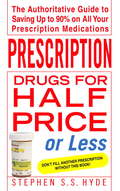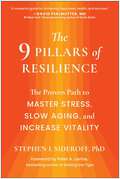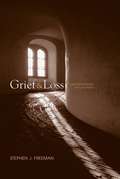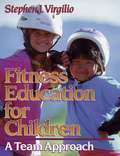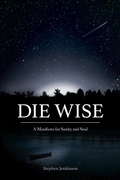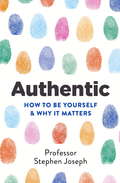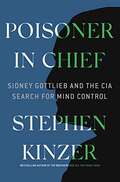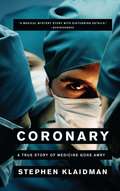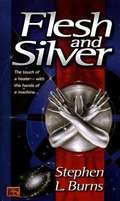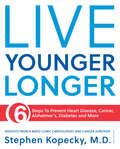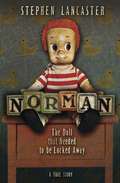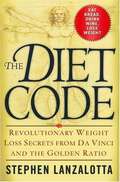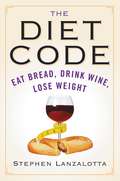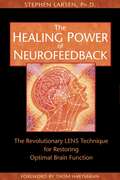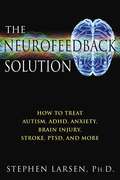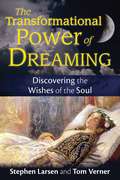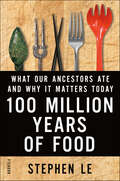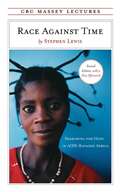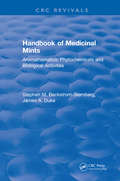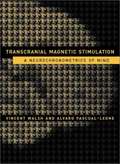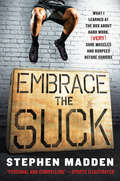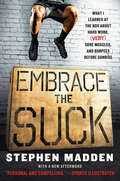- Table View
- List View
Prescription Drugs for Half Price or Less
by Stephen HydeIf you want to save up to 50, 70, even 90% on your prescription drug costs, this is the book you need. Stephen S. S. Hyde, founder of Hyde Rx Services Corporation, is the leading authority on low-cost prescription drug benefits, and now he's offering individual consumers the expertise he provides to America's employers and health plans. With the simple, cost-saving techniques outlined in this revolutionary book, you can save literally hundreds, even thousands of dollars on your family's prescription medications. You'll discover:* The seven questions you should ask your doctor before he writes a prescription * How your pharmacist can save you money * How to get FREE prescription drugs * How to save on generic, over-the-counter, and brand-name drugs * How to get the lowest prices from retail, mail-order, online, and Canadian pharmacies * How you may be eligible for discount cards and other assistance programs * A Special Seniors Medicare Drug Benefit Report, and much more!With an appendix of directories, pharmacies, and websites to get you started, this book will pay for itself with your very first prescription!From the Trade Paperback edition.
The 9 Pillars of Resilience: The Proven Path to Master Stress, Slow Aging, and Increase Vitality
by Stephen I. SideroffStress is a fact of life—and it&’s necessary for success. Discover a holistic methodology based on 9 key pillars to help you thrive even in the midst of overwhelming stress. Individuals at all levels of society and income are feeling the exhausting effects of economic uncertainty, political upheaval, international conflict, the pandemic, and environmental devastation. This timely book offers effective approaches for overcoming everyday challenges, presenting you with the tools you need to neutralize stress, build resilience, and live a balanced life. Drawing on over 40 years of experience, Dr. Stephen I. Sideroff equips you with the techniques needed to adjust the mind and body to the evolutionary mismatch posed by modern forms of stress. Empower yourself to conquer stress, enhance resilience, and improve overall wellness and longevity through an innovative approach that will help you: Prosper with stress rather than letting it weigh you down Maintain good brain health for optimal performance Implement recovery techniques for many common ailments Improve emotional awareness Enhance feelings of self-worth, happiness, and satisfaction Maximize your energy and focus Featuring a 6-page personal guide and assessment to support you on your journey, The 9 Pillars of Resilience makes it simple to establish lifelong physical, emotional, and mental patterns for mastering stress, increasing longevity, and living a joyful, balanced life.
Grief and Loss: Understanding the Journey
by Stephen J. FreemanThis text provides pertinent theoretical and practical information, enhancing the reader's understanding of the process and the dynamics of grief and loss. Freeman views the helping professional's personal feelings, fears, and expectations as significant factors affecting facilitation of the grieving process that must be examined.
Fitness Education for Children
by Stephen J. VirgilioThe complete guide to developing a fitness education program at the elementary school level
Die Wise
by Stephen JenkinsonDie Wise does not offer seven steps for coping with death. It does not suggest ways to make dying easier. It pours no honey to make the medicine go down. Instead, with lyrical prose, deep wisdom, and stories from his two decades of working with dying people and their families, Stephen Jenkinson places death at the center of the page and asks us to behold it in all its painful beauty. Die Wise teaches the skills of dying, skills that have to be learned in the course of living deeply and well. Die Wise is for those who will fail to live forever. Dying well, Jenkinson writes, is a right and responsibility of everyone. It is not a lifestyle option. It is a moral, political, and spiritual obligation each person owes their ancestors and their heirs. Die Wise dreams such a dream, and plots such an uprising. How we die, how we care for dying people, and how we carry our dead: this work makes our capacity for a village-mindedness, or breaks it.Table of ContentsThe Ordeal of a Managed DeathStealing Meaning from DyingThe Tyrant HopeThe Quality of LifeYes, But Not Like ThisThe WorkSo Who Are the Dying to You? Dying Facing HomeWhat Dying Asks of Us AllKidsAh, My Friend the EnemyFrom the Trade Paperback edition.
Authentic: How to be yourself and why it matters
by Stephen JosephThe hunger for authenticity guides us throughout our lives. People strive for joined-up living, where on the one hand what they say and do reflects what they think and feel, and on the other what they think and feel reflects who they are.Stephen Joseph has pioneered developments in research into authenticity, drawing on the solid science of positive psychology to develop what has become one of the gold-standard tests for assessing authenticity. His and others' findings reveal that when people are in relationships in which they feel accepted, understood and valued, they drop their defences. They naturally begin to examine themselves psychologically, accommodate new information and live more authentically. What's more, the latest studies reveal that it is authenticity that leads to true happiness.In Authentic, Stephen Joseph presents his fresh and inspiring perspective on the psychology of authenticity alongside practical advice and exercises for the reader. Drawing on the wisdom of existential philosophers, the insights and research of psychologists, and case studies from his own and others' clinical experiences, he shows how authenticity is the foundation of human flourishing - as well as how the ideas relate to debates about the importance of happiness.
How to Use the I Ching: A Guide to Working with the Oracle of Change
by Stephen KarcherThis book is meant as a accompaniment to the I Ching and it not a translation of the oracle itself. You will need such a translation.
Poisoner In Chief: Sidney Gottlieb And The Cia Search For Mind Control
by Stephen KinzerThe bestselling author of All the Shah’s Men and The Brothers tells the astonishing story of the man who oversaw the CIA’s secret drug and mind-control experiments of the 1950s and ’60s. The visionary chemist Sidney Gottlieb was the CIA’s master magician and gentlehearted torturer―the agency’s “poisoner in chief.” As head of the MK-ULTRA mind control project, he directed brutal experiments at secret prisons on three continents. He made pills, powders, and potions that could kill or maim without a trace―including some intended for Fidel Castro and other foreign leaders. He paid prostitutes to lure clients to CIA-run bordellos, where they were secretly dosed with mind-altering drugs. His experiments spread LSD across the United States, making him a hidden godfather of the 1960s counterculture. For years he was the chief supplier of spy tools used by CIA officers around the world. Stephen Kinzer, author of groundbreaking books about U.S. clandestine operations, draws on new documentary research and original interviews to bring to life one of the most powerful unknown Americans of the twentieth century. Gottlieb’s reckless experiments on “expendable” human subjects destroyed many lives, yet he considered himself deeply spiritual. He lived in a remote cabin without running water, meditated, and rose before dawn to milk his goats. During his twenty-two years at the CIA, Gottlieb worked in the deepest secrecy. Only since his death has it become possible to piece together his astonishing career at the intersection of extreme science and covert action. Poisoner in Chief reveals him as a clandestine conjurer on an epic scale.
Coronary: A True Story of Medicine Gone Awry
by Stephen KlaidmanA chilling real-life medical thriller, Coronary chronicles the story of two highly respected heart doctors who violated the most sacred principle of their profession: First, do no harm. In the summer of 2002, fifty-five-year-old John Corapi, a Catholic priest with a colorful background, visited Dr. Chae Hyun Moon, a celebrated cardiologist in Redding, California. Corapi had been suffering from exhaustion and shortness of breath, and although a physical examination and a conventional stress test revealed nothing abnormal, Moon insisted that the calcium level in Corapi's coronary arteries called for a highly invasive diagnostic test: an angiogram. A chain-smoking Korean immigrant known for his gruff bedside manner, Moon performed the procedure briskly and immediately handed down a devastating diagnosis: "I'm sorry; there is nothing I can do for you. You need a triple bypass tomorrow morning." He then abruptly left the room. Several hours later, however, Moon inexplicably decided the surgery could wait until Corapi returned from a previously scheduled cross-country trip. Unnerved by the dire diagnosis and also by Moon's inconsistent statements, Corapi sought other opinions. To his amazement, a second, third, and fourth doctor found that his heart was perfectly healthy. In fact, for a man his age, Corapi's arteries were remarkably free of disease. Sensing a cause more disturbing than human error, Corapi took his story to the FBI. As local agent Mike Skeen soon discovered, Corapi was one of a number of people who had suspicions about Moon and Moon's go-to cardiac surgeon, Dr. Fidel Realyvasquez, an equally respected member of the close-knit northern California community. Working at a hospital owned by Tenet Healthcare, Moon would make the diagnoses and Realyvasquez would perform the surgeries. Together, these leaders of the Redding medical establishment put hundreds of healthy people at risk, some of whom never recovered. Soon Skeen launched a major investigation, interviewing numerous doctors and patients, and forty federal agents raided the hospital where the doctors worked.A timely and provocative dissection of America's medical-industrial complex, Coronary lays bare the financial structures that drive the American healthcare system, and which precipitated Moon's and Realyvasquez's actions. In a scheme that placed the demands of Wall Street above the lives of its patients, Tenet Healthcare rewarded doctors based on how much revenue they generated for the corporation. A meticulous three-year FBI investigation and hundreds of civil suits culminated in no criminal charges but a series of settlements with Tenet Healthcare and the doctors that totaled more than $450 million and likely put an end to Moon's and Realyvasquez's medical careers. The case's every twist and turn is documented here. A riveting, character-rich narrative and a masterpiece of long-form journalism, Coronary is as powerful as it is alarming. This is a hair-raising story of the hundreds of men and women who went under the knife, not in the name of medicine, but of profit and prestige. Brilliantly told, Stephen Klaidman's Coronary is a cautionary tale in the age of miracle medicine, and a shocking reminder to always get a second opinion.
Flesh and Silver
by Stephen L. BurnsA brilliant doctor gives up his status as a human being when he becomes a Bergmann surgeon--healing fatal sickness and wounds with psychic powers and mechanical precision. Though a great healer, he is an outcast, and he and his kind wander from emergency to emergency, at the beck and call of MedAm. When not working, he is drinking, lost in a fog, trying to forget the things which he has lost. But when a dying despot hijacks him, he is forced to face what his life has become, and--with the help of a killer for hire--reclaim what it means to be a healer.
Live Younger Longer: 6 Steps to Prevent Heart Disease, Cancer, Alzheimer’s and More
by Stephen L. KopeckyIn the past century, the leading causes of death around the world have shifted from infectious diseases to long-term chronic illnesses. What&’s killing us today isn&’t so much flu or tuberculosis, but heart disease and cancer. Paradoxically, these chronic diseases are a consequence of living longer than ever. But even if we&’re living longer, are we living better? The overwhelming number of people now living under the burden of chronic illness indicates otherwise. Live Younger Longer outlines six steps to preserving health while also extending life. The secret lies not just in the steps themselves but in how you accomplish them. To live younger longer, we need to change our habits. But it&’s not necessary to make big life changes or summon depths of will power; in fact, evidence shows that these tactics don&’t really work. What you need instead is an open mind, some creativity and a commitment to living your life at its fullest. In this book, Stephen Kopecky, M.D., offers his insights on: The best foods to eat and whyGetting the most fitness in the least amount of timeWhy your sleep habits matterThe dangers of stress and what to do about themHow to make changes that will last a lifetime Dr. Kopecky speaks from experience. As a young man just starting his family and his career, he survived cancer not once but twice. Since then, Dr. Kopecky has dedicated himself to discovering what it is that will keep him alive and healthy for as long as possible. In this book, he shares what he&’s learned — through research, care for his patients and his own experiences.
Norman: The Doll That Needed to Be Locked Away (A True Story)
by Stephen LancasterNorman takes you on a chilling journey into Stephen's life with a doll that has held the spirit of an unborn child for over fifty years--a haunted doll that still lives in Stephen's house.
The Diet Code: Revolutionary Weight Loss Secrets from Da Vinci and the Golden Ratio
by Stephen LanzalottaFrom the book: AN ANCIENT FORMULA. A UNIQUE EATING PLAN. THE SECRET TO WEIGHT LOSS REVEALED. Shed pounds naturally by rediscovering a universal, age-old formula used by Da Vinci and other masters of the Renaissance. THE DIET CODE reveals how you can use the perfect proportion of carbohydrates, proteins, and fats to maximize health and weight loss through a three-phase program complete with delicious menu plans, easy-to-prepare recipes, and time-tested nutritional advice. You'll fill your table with the same whole, natural foods you like best, including bread, wine, cheese, pasta (and dessert!), combining them in ways that boost your metabolism and promote fat loss. You hold in your hands the solution you've been searching for-a simple, satisfying approach to eating for a slimmer and healthier you. You are about to crack The Diet Code.
The Diet Code: Revolutionary Weight Loss Secrets from Da Vinci and the Golden Ratio
by Stephen LanzalottaEat bread and cheese, drink wine-and lose weight!The secret lies in an ancient mathematical formula now transformed into ... THE DIET CODE. As a master baker and craftsman, Stephen Lanzalotta had been applying the mathematical principles of the Golden Ratio for more than twenty years. His realization that this ancient, universal formula, used by Da Vinci and other great geniuses of the Renaissance, also held the secret to optimal nutrition and health led him to apply it to his own diet and the menu at his popular cafe. The weight loss and sense of well-being that he and his customers experienced convinced him that he had cracked the diet code, discovering a simple, natural, and nutritious approach to healthy eating that is as easy as 1, 2, 3. His revolutionary Mediterranean-style eating program uses the Golden Ratio to link the proper proportions of everyday foods to boost metabolism and spark weight loss. Combining a three-phase eating program with detailed menu plans, mouthwatering recipes, Renaissance lore, and Italian-inspired lifestyle advice, THE DIET CODE is a unique health and weight loss program from the ages for the ages. In it readers will: * Crack the diet code--discover how the Golden Ratio can work for you to boost metabolism and maximize nutrition and weight loss; * Forget about the math--it's all done for you, and the net result is deliciously simple: 1 part grain carbohydrate, 2 parts protein, 3 parts vegetables at every meal; * Enjoy bread again! It really is the staff of life--as long as you eat it along with the right amount of fat or protein; * Experience natural weight control--choose and properly prepare healthful, readily available foods as they did during the Renaissance. THE DIET CODE is a unique approach to eating well based on a mathematical phenomenon that's been around for centuries but has never before been applied to diet. Now prepare to lose weight and get healthy by asking yourself, "What would Da Vinci eat?"
The Healing Power of Neurofeedback: The Revolutionary LENS Technique for Restoring Optimal Brain Function
by Thom Hartmann Stephen LarsenAn introduction to the innovative therapy that restores optimal functioning of the brain after physical or emotional trauma• Provides an alternative to the more invasive therapies of electroshock and drugs• Shows how this therapy helps ameliorate anxiety and depression as well as childhood developmental disorders• Includes extraordinary case histories that reveal the powerful results achievedAccording to the Centers for Disease Control, each year 260,000 people are hospitalized with traumatic brain injuries. The Brain Injury Association reports 1.5 million injuries, many of which go undiagnosed but which lead to all kinds of cognitive and emotional impairments. While neuroscience has learned an enormous amount about the connection between brain trauma and personality changes, the methods proposed for resolving these alterations are generally limited to drug therapy or surgeries.This book explores a much less invasive but highly effective technique of restoring brain function: the Low Energy Neurofeedback System (LENS). Developed by Dr. Len Ochs in 1992, it has had extraordinary results using weak electromagnetic fields to stimulate brain-wave activity and restore brain flexibility and function. The treatment works across a broad spectrum of human activity, increasing the brain’s abilities to adapt to the imbalances caused by physical trauma or emotional disorders--both on the basic level and in the more subtle areas of cognitive, affective, and spiritual processes that make us truly human. While the treatment has had remarkable results with individuals who have experienced severe physical trauma to the head and brain, Stephen Larsen sees it also as an important alternative to chemical approaches for such chronic behavioral disorders as ADHD and monopolar and bipolar depression.
The Neurofeedback Solution: How to Treat Autism, ADHD, Anxiety, Brain Injury, Stroke, PTSD, and More
by Stephen LarsenA guide to neurofeedback for better physical and mental health as well as greater emotional balance, cognitive agility, and creativity • Provides easy-to-understand explanations of different neurofeedback methods--from the LENS technique to Z-score training • Explains the benefits of this therapy for anxiety, depression, autism, ADHD, post-traumatic stress disorder, obsessive-compulsive disorder, brain injuries, stroke, Alzheimer’s, and many other ailments • Explores how to combine neurofeedback with breathwork, mindfulness, meditation, and attention-control exercises such as Open Focus What is neurofeedback? How does it work? And how can it help me or my family? In this guide to neurofeedback, psychologist and neurofeedback clinician Stephen Larsen examines the countless benefits of neurofeedback for diagnosing and treating many of the most debilitating and now pervasive psychological and neurological ailments, including autism, ADHD, anxiety, depression, stroke, brain injury, obsessive-compulsive disorder, and post-traumatic stress disorder. Surveying the work of neurofeedback pioneers, Larsen explains the techniques and advantages of different neurofeedback methods--from the LENS technique and HEG to Z-score training and Slow Cortical Potentials. He reveals evidence of neuroplasticity--the brain’s ability to grow new neurons—and shows how neurofeedback can nourish the aging brain and help treat degenerative conditions such as Alzheimer’s and strokes. Examining the different types of brain waves, he shows how to recognize our own dominant brainwave range and thus learn to exercise control over our mental states. He explains how to combine neurofeedback with breathwork, mindfulness, meditation, and attention-control exercises such as Open Focus. Sharing successful and almost miraculous case studies of neurofeedback patients from a broad range of backgrounds, including veterans and neglected children, this book shows how we can nurture our intimate relationship with the brain, improving emotional, cognitive, and creative flexibility as well as mental health.
The Transformational Power of Dreaming: Discovering the Wishes of the Soul
by Stephen Larsen Tom VernerAn exploration of dreaming history, science, traditions, and practices from prehistory to today• Examines ancient dream traditions from around the world, shamanic dreaming, and the profound role of dreaming in Native American and African-American cultures• Investigates dream psychology and the neuroscience of the dreaming brain• Explores the practice of dream incubation, lucid dreaming, and telepathic dreaming with tips on remembering your dreams and working with themWe have been dreaming for all of our 3 million or more years of existence. Dreams provide an extraordinary way to process the day’s events and uncover new perspectives. Many cultural creatives credit their world-changing creations to their dreams, and science now believes that dreams helped evolve the very process of thought itself.In this book, Stephen Larsen and Tom Verner examine dream traditions from around the world, beginning with the oldest records from ancient Egypt, India, Greece, and Australia and expanding to shamanic and indigenous societies. The authors investigate the psychology of dreaming, the neuroscience behind the dreaming brain, the Jungian perspective, and the intersections of yoga and modern dream research. They show how dreams and myth are related in the timeless world of the Archetypal Imagination and how dreams often reveal the wishes of the soul. They explore the practice of dream incubation, an age-old tradition for seeding the unconscious mind to help solve problems and gain deep insights. They examine the profound role that dreams have played in the survival of exploited and persecuted cultures, such as the Native Americans, African slaves, and the Jews during the Holocaust, and share inspirational dream stories from exceptional woman dreamers such as Hildegard von Bingen, Joan of Arc, and Harriet Tubman.Drawing on their more than 50 years’ experience keeping dream journals, the authors offer techniques to help you remember your dreams and begin to work with them. They also explore the clairvoyant and telepathic dimensions of dreaming and the practices of lucid dreaming and shamanic dreaming. Revealing how the alchemical cauldron of dreaming can bring inspiration, healing, and discovery, the authors show how dreams unite us with each other and the past and future dreamers of our world.
100 Million Years of Food: What Our Ancestors Ate and Why It Matters Today
by Stephen LeA fascinating tour through the evolution of the human diet and how we can improve our health by understanding our complicated history with food.There are few areas of modern life that are burdened by as much information and advice, often contradictory, as our diet and health: eat a lot of meat, eat no meat; whole grains are healthy, whole grains are a disaster; eat everything in moderation; eat only certain foods--and on and on. In 100 Million Years of Food, biological anthropologist Stephen Le explains how cuisines of different cultures are a result of centuries of evolution, finely tuned to our biology and surroundings.Today many cultures have strayed from their ancestral diets, relying instead on mass-produced food often made with chemicals that may be contributing to a rise in so-called Western diseases, such as cancer, heart disease, and obesity.
Race Against Time: Searching for Hope in AIDS-Ravaged Africa (The CBC Massey Lectures)
by Stephen Lewis"I have spent the last four years watching people die." With these wrenching words, diplomat and humanitarian Stephen Lewis opens his 2005 CBC Massey Lectures. Lewis's determination to bear witness to the desperate plight of so many in Africa and elsewhere is balanced by his unique, personal, and often searing insider's perspective on our ongoing failure to help. Lewis recounts how, in 2000, the United Nations Millennium Summit in New York introduced eight Millennium Development Goals, which focused on fundamental issues such as education, health, and cutting poverty in half by 2015. In audacious prose, alive with anecdotes ranging from maddening to hilarious to heartbreaking, Lewis shows why and how the international community is falling desperately short of these goals. This edition includes an afterword by Lewis, covering events after the lectures were delivered in fall 2005.
Handbook of Medicinal Mints: Aromathematics: Phytochemicals and Biological Activities
by Stephen M Beckstrom-SternbergInterest in herbal medicines, aromatherapy, and other traditional applications of aromatic plants has increased tremendously over the last few years. However, very little "hard data" on the properties and uses of these plants has been available until now. This handbook provides the most complete collection of chemical data available on aromatic mints (Lamiaceae). The authors introduce the new field of study, aromathematics, which involves aromatic compounds and their biological activities. This book contains a wealth of quantitative data, including more than 500 references on 10,839 chemicals from 251 assays of 205 unique taxa, combined with 3,324 biological activities and 256 recommended daily allowances and lethal doses. An exhaustive guide, the handbook is the ultimate resource for assessing the potential medicinal value of a particular species.
Transcranial Magnetic Stimulation: A Neurochronometrics of Mind
by Stephen M. Kosslyn Vincent Walsh Álvaro Pascual-LeoneThe mainstays of brain imaging techniques have been positron emission tomography (PET), functional magnetic resonance imaging (fMRI), magnetoencephalography (MEG), and event-related potentials (ERPs). These methods all record direct or indirect measures of brain activity and correlate the activity patterns with behavior. But to go beyond the correlations established by these techniques and prove the necessity of an area for a given function, cognitive neuroscientists need to be able to reverse engineer the brain--i.e., to selectively remove components from information processing and assess their impact on the output. This book is about transcranial magnetic stimulation (TMS), a technique that emerged during the same period as neuroimaging and has made it possible to reverse engineer the human brain's role in behavioral and cognitive functions. The subject areas that can be studied using TMS run the gamut of cognitive psychology--attention, perception, awareness, eye movements, action selection, memory, plasticity, language, numeracy, and priming. The book presents an overview of historical attempts at magnetic brain stimulation, ethical considerations of the technique's use, basic technical and practical information, the results of numerous TMS studies, and a discussion of the future of TMS in the armamentarium of cognitive neuropsychology.
Antidepressants
by Stephen M. StahlAll of the titles in the Stahl's Illustrated Series are designed to be fun. Concepts are illustrated by full-color images that will be familiar to all readers of Stahl's Essential Psychopharmacology, Third Edition and The Prescriber's Guide. The texts in this user-friendly series can be supplements to figures, images, and tables. The visual learner will find that these books make psychopharmacology concepts easy to master, while the non-visual learner will enjoy a shortened text version of complex psychopharmacology concepts. Within each book, each chapter builds on previous chapters, synthesizing information from basic biology and diagnostics to building treatment plans and dealing with complications and comorbidities. Novices may want to approach Stahl's Illustrated Series by first looking through all the graphics and gaining a feel for the visual vocabulary. Readers more familiar with these topics should find that going back and forth between images and text provides an interaction with which to vividly conceptualize complex pharmacologies. And, to help guide the reader toward more in-depth learning about particular concepts, each book ends with a Suggested Reading section.
Stahl's Illustrated: Sleep and Wake Disorders
by Stephen M. StahlStahl's Illustrated Sleep and Wake Disorders is a concise and highly illustrated guide to the environmental, neurobiological and genetic factors that influence sleep and wakefulness, with evidence-based guidance for the accurate diagnosis and optimal treatment of various sleep/wake disorders. All of the titles in the Stahl's Illustrated series are designed to be fun. Concepts are illustrated by full-color images that will be familiar to all readers of Stahl's Essential Psychopharmacology and The Prescriber's Guide. The visual learner will find that these books make psychopharmacology concepts easy to master, while the non-visual learner will enjoy a shortened text version of complex psychopharmacology concepts. Within each book, each chapter builds on previous chapters, synthesizing information from basic biology and diagnostics to building treatment plans and dealing with complications and comorbidities.
Embrace the Suck
by Stephen MaddenTo be fit, or CrossFit?Lifelong amateur athlete Stephen Madden decided to put himself to the test. He immersed himself in the culture, diet, and psyche of CrossFit--the fast-growing but controversial fitness regime that's a stripped-down combination of high-intensity aerobic activity, weightlifting, calisthenics, and gymnastics. Madden is just one of over two million athletes worldwide to do so. But what's crazier? The fact that such a grueling regimen--in which puking and muscle breakdowns during workouts are common--is so popular, or that people pay good money to do it?In Embrace the Suck, the former editor-in-chief of Bicycling magazine explores with irreverence, humor, and soul-touching candor the fitness revolution sweeping America. Madden chronicles the year he devoted to trying to master all the basic CrossFit exercises, like double unders, muscle-ups, and kipping pullups, and immersing himself in the Paleo diet that strips weight from its followers but leaves them fantasizing about loaves of bread. Along the way, he explores the culture of the sport, his experience becoming a CrossFit coach, and some basic questions about himself, his past, and his athletic limitations--and why something so difficult and punishing can be at once beautiful, funny, and rewarding.Whether you are a CrossFitter or a nascent athlete, you will come away from this book understanding the limitless potential of the human body and mind, and will learn what it takes to welcome and defeat any kind of suck.
Embrace the Suck: What I Learned at the Box ABout Hard Work, (Very) Sore Muscles, and Burpees Before Sunrise
by Stephen MaddenTO BE FIT, OR CROSSFIT?Lifelong amateur athlete Stephen Madden immersed himself in the culture, diet, and psyche of CrossFit—the fast-growing but controversial fitness regime that’s a stripped-down combination of high-intensity aerobic activity, weightlifting, calisthenics, and gymnastics. Madden is just one of more than two million athletes worldwide to do so. In Embrace the Suck, the former editor in chief of Bicycling magazine explores with irreverence, humor, and soul-touching candor the fitness revolution sweeping America. Madden chronicles the year he devoted to trying to master all the basic CrossFit exercises, like double unders, muscle-ups, and kipping pull-ups, and immersing himself in the Paleo diet that strips weight from its followers but leaves them fantasizing about loaves of bread. Along the way, he explores the culture of the sport, his experience of becoming a CrossFit coach, and some basic questions about himself, his past, and his athletic limitations—and why something so difficult and punishing can be at once beautiful, funny, and rewarding.Whether you are a CrossFitter or a nascent athlete, you will come away from this book understanding the limitless potential of the human body and mind, and will learn what it takes to welcome and defeat any kind of suck.
